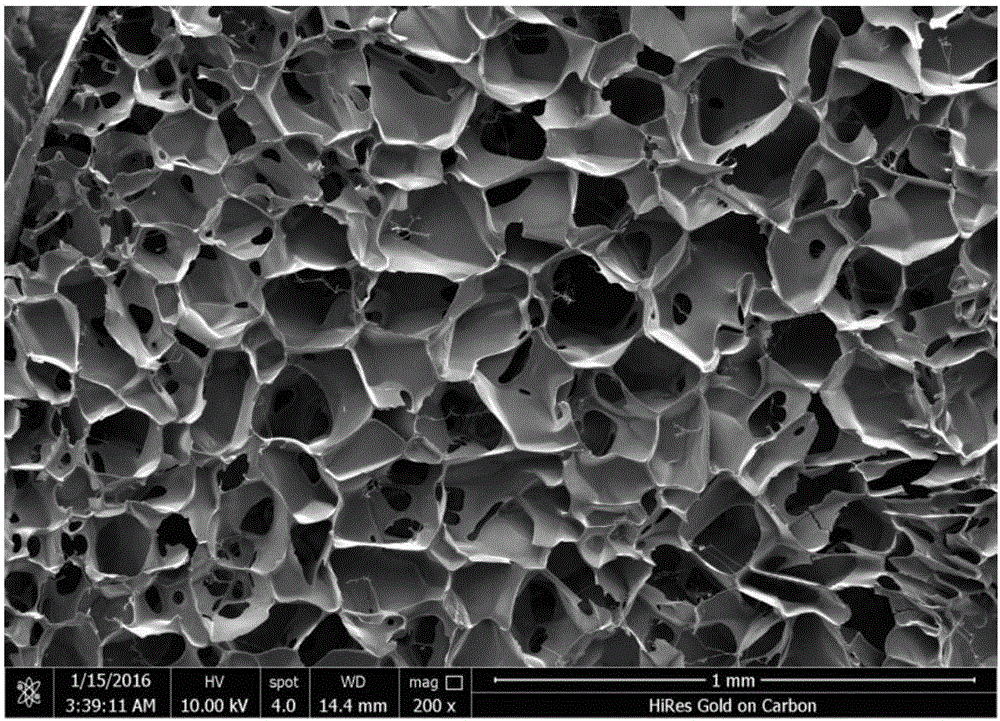Preparation method of secondary structure controllable silk fibroin porous material with no need of organic solvent
A technology of silk fibroin and porous materials, which is applied in the fields of pharmaceutical formula, medical science, prostheses, etc. It can solve the problems of unfavorable large-scale production, harmful environment in the preparation process, slow degradation, etc., and achieve good porosity and non-toxicity Side effects, easily modifiable effects
- Summary
- Abstract
- Description
- Claims
- Application Information
AI Technical Summary
Problems solved by technology
Method used
Image
Examples
Embodiment 1
[0030] Prepare silk fibroin solution. Specifically: put 60g silk in 0.02M Na 2 CO 3 Boil in the solution at 100°C for 30 minutes to remove sericin on the outside of the silk, rinse with deionized water, repeat the above operation 3 times, and then dry the silk at 60°C. Weigh 27 g of the degummed silk after the above treatment and dissolve in 100 mL of 9.3 mol / LLiBr solution, and dissolve at 60° C. for 4 hours. Then use a dialysis bag with a molecular weight cut-off of 3500 to immerse in deionized water and dialyze for 3 days, during which the water is changed every two hours to remove LiBr in the solution, thereby obtaining a pure silk fibroin solution with a concentration of 6%.
[0031] After the silk fibroin solution was placed at -4°C for 48 hours, it was then frozen at -2°C for 24 hours. After being put into a lyophilizer and dried for 48 hours, the nano silk protein porous material was obtained.
[0032] See figure 2 , figure 2 It is an electron micrograph of the...
Embodiment 2
[0034] A pure silk fibroin solution with a concentration of 6% was prepared by the same method as in Example 1.
[0035] After the silk fibroin solution was placed at -20°C for 48 hours, it was then frozen at -4°C for 24 hours. After being put into a lyophilizer and dried for 48 hours, the nano silk protein porous material was obtained.
[0036] See image 3 , image 3 It is the electron micrograph of the silk protein scaffold obtained by the salting-out method after vacuum drying of the concentrated silk fibroin solution described in Example 2. It can be seen from the figure that the pore diameter of the above scaffold is about 188.35±19.41 μm.
Embodiment 3
[0038] A pure silk fibroin solution with a concentration of 6% was prepared by the same method as in Example 1.
[0039] The mass fraction of the silk fibroin solution was adjusted to 1% with deionized water, and the adjusted silk fibroin solution was placed at -70°C for 0.5 hours, and then frozen at -5°C for 96 hours. After being put into a lyophilizer and dried for 48 hours, the nano silk protein porous material was obtained.
PUM
| Property | Measurement | Unit |
|---|---|---|
| pore size | aaaaa | aaaaa |
| diameter | aaaaa | aaaaa |
| percent by volume | aaaaa | aaaaa |
Abstract
Description
Claims
Application Information
 Login to View More
Login to View More - R&D
- Intellectual Property
- Life Sciences
- Materials
- Tech Scout
- Unparalleled Data Quality
- Higher Quality Content
- 60% Fewer Hallucinations
Browse by: Latest US Patents, China's latest patents, Technical Efficacy Thesaurus, Application Domain, Technology Topic, Popular Technical Reports.
© 2025 PatSnap. All rights reserved.Legal|Privacy policy|Modern Slavery Act Transparency Statement|Sitemap|About US| Contact US: help@patsnap.com



